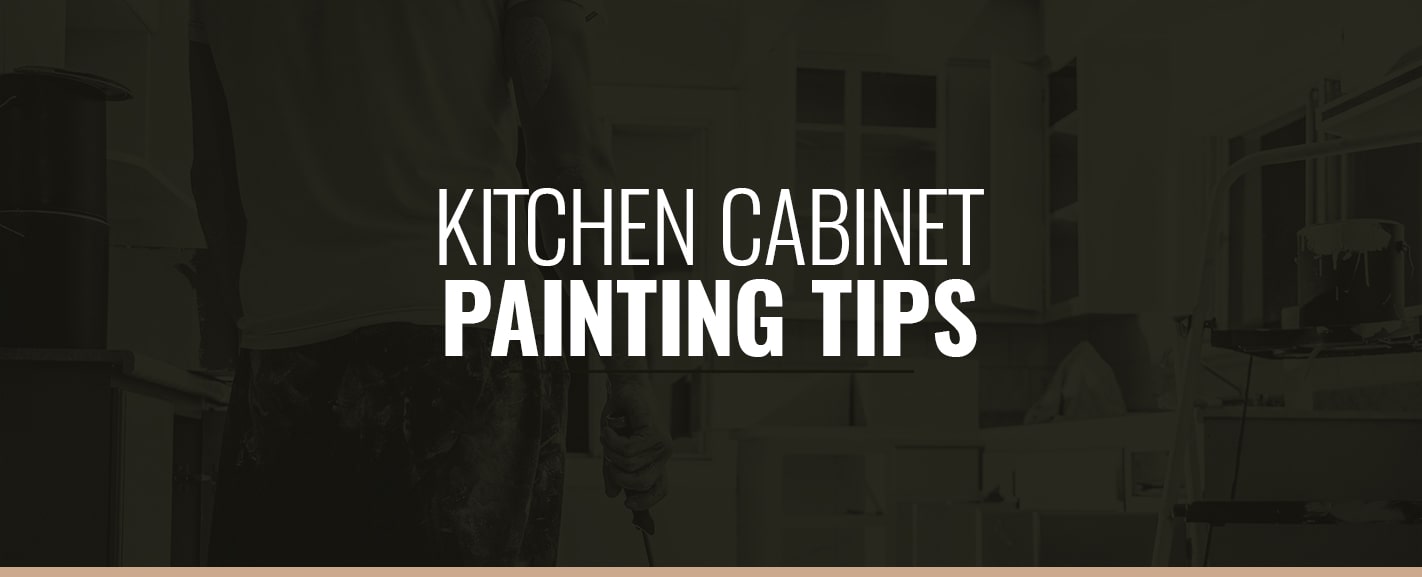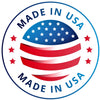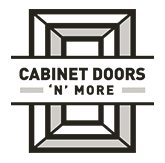
Choosing to paint your existing kitchen cabinets can transform the entire look of your space and is often a better solution than a major remodeling project. In this guide, we'll help you decide whether painting your cabinets is the right choice for you — and if so, we'll share with you the best materials and practices to use for the project.

SHOULD I PAINT MY KITCHEN CABINETS?
Whether you decide to paint your kitchen cabinets will depend on several factors, including the cabinets' condition, how long you plan to live in your home and the current layout of the cabinets.
If you like the layout of your cabinetry and it's in great condition, you can save a lot of money by painting your cabinets. On the other hand, if your cabinetry is showing signs of wear, it probably won't help much to paint your cabinets. If you'd like to add more cabinetry or reconfigure your cabinet layout and appliances, it makes more sense to invest in new cabinetry.
Consider the pros and cons of each option to determine which choice works best for your situation.

WHAT COLOR SHOULD I CHOOSE?
When it comes to painting kitchen cabinet doors and cabinets entirely, the only rule is there aren't any rules. It mainly comes down to your tastes and whether you're planning to put your house on the market in the near future. For example, most buyers will prefer neutral colors, so consider going subtle if you're planning on selling. Alternatively, feel free to go bold if you're staying put. Painting raised panel cabinet doors gives you a chance to use more than one color.
Here are some color ideas to explore:
-
Warm neutrals:If you haven't decided which new paint color to pick, think about grays, light tans, off-white or other mid-range neutrals. These shades seamlessly blend with other colors or patterns in your kitchen and go well with practically any decor.
-
Reds: If you're looking to make a bold, bright statement, red tones are great for brightening a dark kitchen and making it more exciting. It can also be used as an accent color to draw people's attention to a certain focal point.
-
Rich browns:A traditional option, rich browns provide kitchens with a cozy farmhouse feeling that's inviting and warm.
-
Yellow: As a popular color for kitchens, yellow provides sunny warmth and works well in both transitional and traditional designs.
-
White: If you're a fan of contemporary styles, the simple, clean appearance of bright white is an option to consider. It provides a nice contrast with darker countertops or furniture for a balanced feel.
-
Blue: Although not currently a popular color for kitchens, blue accents are a great way to make your kitchen feel calmer and inviting.

REQUIRED TOOLS AND MATERIALS
Painting cabinet doors or cabinets as a whole requires a lot more than the obvious paint and paintbrush. Before you undergo this project, we recommend that you acquire all of the following materials and equipment:
-
Painter's tape: Painter's tape is a great tool for protecting areas you don't want to paint. Pick up some blue painter's tape or frog tape before you begin.
-
Rags: You'll need many rags to clean your cabinets, wipe off dust, wipe up spills and clean your hands.
-
Five-in-one painter's tool:This useful tool can press tape, cut tape, open cans and more.
-
Latex gloves: These will make cleanup much easier, saving your hands from becoming dirty.
-
Sanding sponges: You'll be using sanding sponges during several stages of the cabinet painting process, with each step requiring a different sponge roughness. When first sanding the cabinets to prime them for painting, use a medium-grit sanding sponge, and after applying the primer coat, use a fine-grit sponge. Between the application of your topcoats, use an extra fine-frit sanding sponge.
-
Charcoal face masks: No matter whether you're using oil- or latex-based paint, using a charcoal face mask is a wise safety decision.
-
Brown rosin paper: Brown rosin paper is a durable material you can use to prep your floors and countertops.
-
Paint mixing cups: If you're like some, you may not use your paint straight from the can and instead thin it down with paint thinner or water. To get your mix perfect, it can be helpful to have several mixing cups with measurements on the side.
-
Paintbrush: We recommend using a 1.5- to 3" paintbrush. For oil-based paint, use a white bristle, and for latex paints, use a latex brush.
-
Painter's plastic: Use painter's plastic to block off your room, prep off your countertops and more.
-
Masking film: 48" masking film works wonderfully for the insides of your cabinets.

EXTRA EQUIPMENT FOR BRUSHING AND ROLLING
If you plan to apply your paint with a brush or roller, you'll need the following:
-
4" paint roller:4" rollers are ideal for cabinets, as they provide a decent-sized surface while still giving you good control.
-
6"-by-4" paint roller pads: 4" roller covers with a nap measuring 3/8" are perfect for painting kitchen cabinets. It's best to spend the money for quality pads, as cheap ones will shed all over in your finish.
-
Disposable roller trays: Look for tiny roller trays to hold your paint.

EXTRA EQUIPMENT FOR SPRAYING
You'll also need a few extra tools if you choose to spray paint your cabinets. These include:
-
Painter's plastic: Painter's plastic is great for prepping off your cabinets' insides and appliances. It also is great for walling off your work area to keep overspray from unwanted areas.
-
HVLP paint sprayer: A high-volume, low-pressure (HVLP) paint sprayer is unlike conventional spray guns in that they don't use high-pressure air. Instead, MVLP guns conserve air pressure, which reduces overspray, meaning you cut down on paint waste by roughly half.
-
Full-face respirator: The full-face charcoal mask is a step up from the basic charcoal mask and covers your mouth, nose and eyes, meaning it protects you against harmful vapors.
-
Paint suit: With a paint suit, you can stay clean and free from overspray. It'll also protect your skin from absorbing the volatile organic compounds (VOCs) that different paints release.
TIPS FOR PAINTING KITCHEN CABINETS
Priming and painting your kitchen cabinets will take several days to complete, so you'll need to plan and possibly even set up a temporary kitchen in another room of the house. We recommend wearing the appropriate safety gear and making sure you have the proper ventilation whether refinishing inside or outside. For the best results, you should remove the cabinet doors, drawer fronts and drawer boxes and work on them in a garage or basement if possible.
One of the first steps is to determine the condition of your cabinets. If your cabinet doors or drawer fronts are dented, cracked or worn, you can easily order replacement custom-sized cabinet doors and drawer fronts. One big advantage in doing this is you can not only change the appearance or finish of your cabinets but also change the look. If you had traditional raised panel cabinet doors and conventional slab drawer fronts, you might want to consider an entirely new look. Maybe a more contemporary look with Shaker- or slab-style cabinet doors and drawer fronts.
There are plenty of cabinet door styles to choose from that can easily be ordered online in just days! If you plan on painting new cabinet components, we recommend either using a paint-grade hard maple or MDF (medium-density fiberboard) material. Both are low-cost options and easy to paint. If your cabinet drawer boxes are broken or falling apart this might be a good opportunity to replace those, as well.
Both cabinet doors and drawer fronts that are already painted can be painted again, but we recommend their original surfaces be removed. Stripping products are available online or at your local home improvement store. Follow the directions step-by-step and it should be easy to remove either the existing paint. Once the cabinet doors and drawer fronts dry, you can lightly sand the cabinet doors to remove any excess surface material and make sure the unfinished cabinet doors and drawer fronts are ready for the next steps.
Some other tips on how to paint kitchen cabinets include:

-
Pick the appropriate paint: Regular wall paint isn't suitable for painting cabinets and other similar surfaces. It tends to chip and stands up poorly to repeated cleanings. It's more expensive, but picking an alkyd enamel will hold up better and the formulas are self-leveling, which provides a finish that's smoother.
-
Pick a color that goes well with your appliances: If all the appliances in your kitchen are black, they won't look good when surrounded by oak cabinetry, for example. If you stain your oak cabinets dark brown, however, the black appliances will blend better.
-
Take out all of the hardware: Take out all the hardware, including the hinges, knobs and every last screw. You should even remove the magnets, which help the door stay shut. It'll take a while to remove all the components, but you'll appreciate having a clean surface when you start painting.

-
Organize the hardware: Once you're finished, you'll want to be able to put every piece of hardware back where it belongs. One way to do this is to label each door by number, and you can write the number where the hinge goes into the frame. Then, label a plastic bag filled with hardware from that door with the same number. The tiny space where you wrote the number should be concealed enough that it won't be noticed. Ideally, it should be hidden behind the hinge.
-
Pack your cabinets neatly: Pack plastic bins for the contents of each pantry-like cabinet. This way, you can return the contents easily once you're done. Stack appliances out of the way, and keep your most frequently used cookware, such as your biggest pot and frying pan, on the cooktop. We recommend transferring your silverware into mugs and keeping them on your dining table, as you'll still need them to be easily accessible throughout your painting job.
-
Clear your countertops and roll up your rugs: You'll make a mess, so you'll want to get everything that could possibly be ruined out of the way. This also includes removing your curtains.
-
Think about purchasing or renting an electric sander: No matter what the surface material is that you're refinishing, you should sand all the surfaces to create a good area to which your primer and paint can adhere. You'll have a lot of surfaces to cover, so we recommend an orbital detail sander to make the process faster and prep your surface evenly. It'll also be a lot easier on your muscles.
-
Buy lots of sandpaper: Purchase multiple sandpaper packs to fit in your sander.
-
Buy lots of tack cloths: Cleaning your surface is just as important as sanding it. After sanding, wipe the surface using a tack cloth to remove the debris and dust. We recommend using rubber gloves when you do this, as the cloth is quite sticky.
-
Apply an oil-based primer: Using an oil-based formula will reduce the chances of the hardwood discoloring painted white cabinets. Wood often bleeds through, giving the paint a yellow tinge, especially if the wood is knotty. This oil-based primer also creates a great surface for painting.
-
Purchase canvas drop cloths:Canvas drop cloths are highly affordable, and you only have to buy one or two and move them around as necessary.
-
Purchase disposable paint trays: Get yourself 10 or so of these cheap trays, and it'll make your project much easier. Place these plastic disposable trays into your real tray, which will allow you to roll on a firm surface. The clean-up is also easy, as all you have to do is throw it out when you're done.
-
Purchase additional paint brushes and rollers: Enamel paint can be easily cleaned up with water and soap, and you can reuse the brushes many times. However, cleaning up oil-based paints is considerably more difficult. Even if you do clean the oil-based paint off your brushes, you can only use it a couple more times before the brush's bristles begin to go haywire, which makes it difficult to perform meticulous touch-ups. Having backups always helps.
-
Seal your brushes and rollers in plastic wrap overnight:If you seal them up, the paint on the bristles won't dry, meaning they'll be ready for the following day's work. Painting cabinets usually takes several days, so you want to keep your tools in order.
-
Use appropriate paint rollers: You must pick one type of roller for your primer and another for your paint. Look at the options in your hardware store's painting aisle and the descriptions on the packaging to help you make the right decisions. Keep an eye out for words like "mirror finish" and "smooth cabinet finish." High-density foam rollers are perhaps most suitable for applying oil-based primer, and low-nap "mirror finish" rollers are great for rolling the paint itself.
-
Use painter's tape: While cutting in by hand might work better for trim and along the walls, painter's tape will be very useful in many situations, especially in nooks and crannies around appliances.
-
Prioritize the backs of the cabinet doors and the cabinet bases first:If you can, start by sanding everything at once to get it all out of the way. Next, apply primer and paint to the bases of cabinet bases and door backsides. The reason for this is so these areas can have a couple of extra days to dry. The backsides of the doors and the base cabinets are what make the most contact, so letting them dry for longer will be beneficial later on. Extra tip — try to paint the front of the door last, so you won't ever need to flip it over to paint the back, risking smudges and scratches.
-
Make sure your coats aren't too heavy: There are several reasons to keep your coats light. For one, drips will occur, and if it's enamel paint, it'll start curing right away, which could lead to noticeable drip marks, which you'll have to sand out and repaint. Another reason is low-nap rollers aren't mean to handle lots of paint at a time — it leads to a stippled finish you'll have to sand down and repaint later. The thinner you can make your coats, the better.
-
Apply a polyurethane top coat: This additional coat protects the paint finish against wear and tear. When applying this coat, use a clear low-nap roller or a high-density foam roller.
-
Remember to paint the cabinets' insides: This goes especially for the upper cabinets, which you'll see whenever you open up the cabinet doors. Make the extra effort to sand the inside and paint them — even the shelf bottoms you'll see when reaching for an item that's high up.
-
Decide whether you'll paint the inside shelves or use contact paper: Contact paper will up the price of your project, as the rolls won't cover as much surface area as you'd expect. However, on the plus side, it's not as hard to clean or replace.
-
Clean your hardware while it's off:After handling your hardware for years, they're bound to be a little dirty — perhaps more than you're aware. To clean your metal hardware, mix Bar Keeper's Friend and some water, then soak the hardware in it to loosen the grime. Then, wipe down the pieces using a damp cloth. Make sure it dries fully before you install it on your cabinet again, especially the knobs, which can easily take on water.
-
Attach your hardware to the door first, then install your door to your cabinet: You should be able to see the screw holes from when you removed the hardware. These holes will serve as your guide for reinstalling, and if you follow them, the doors should fit just as they did before.

-
Have a helper:When you install your upper cabinet doors, have someone assist you. While lower cabinets can be installed by yourself relatively easily, when working over your head, having a helping hand makes the task much easier.

CHOOSE CABINET DOORS 'N' MORE FOR ALL YOUR REMODELING NEEDS
For new, replacement cabinet doors, drawer fronts, drawer boxes and all of your cabinet remodeling needs, turn to the leader in the online kitchen cabinetry industry – Cabinet Doors ‘N’ More. You can order as little as one cabinet door front for a quick repair, or a multitude of cabinet components for a large-scale project. Whatever you need, we have the custom, high-quality replacement cabinet components you can count on for your DIY project. Click through our extensive collection, and start our easy-to-use ordering process today!
Contact Us For More Info
Learn More About Painting & Staining Cabinets














Sara Peterson
September 29, 2023
These are great cabinet painting tips! So detailed, I’ll be referring back to this list in the future!